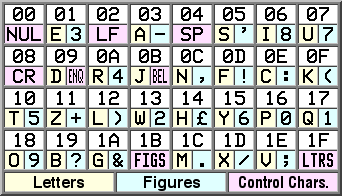I recall burning three or four weeks of a sabbatical getting Saccade.com on the air with Wordpress. So much tweaking…
Question regarding the ITA2 “Baudot” code…
While looking at the hadie high altitude balloon project, I got to thinking about making a microcontroller that could send RTTY. I knew that traditional Baudot (more properly the ITA2 code) was a five bit code with codes designed to switch back and forth between “letters” and “figures”, but I had never looked at the actual matrix. Here is the diagram from Wikipedia:
Tell me, is there ANY rhyme or reason to this layout? It literally looks like they just scattered the letters and numbers onto the codes more or less completely at random.
I was just curious: can anyone tell me what I am missing?
Comments
Comment from Tom Duff
Time 12/21/2011 at 6:10 pm
I think I remember (but I could be wrong) that the Baudot code directly encodes which solenoids to pull on some particular piece of teletype equipment.
Comment from jerry
Time 12/21/2011 at 7:39 pm
http://en.wikipedia.org/wiki/Baudot_code
http://en.wikipedia.org/wiki/Letter_frequencies
it seems to me: Donald Murray used his own letter frequencies statistics (different from the one for Morse code) to minimize punched holes in a paper tape. So the question remains: where did he get his distribution?
73 de na0m
Comment from Mark VandeWettering
Time 12/22/2011 at 11:02 am
Ah, very good! I hadn’t considered that possibility. I suspected there was some rhyme and reason to the layout, and I’m sure that you’re corrrect. Thanks Jerry! It was really bugging me. 🙂
Comment from Brent Jones
Time 1/8/2012 at 6:18 pm
I am not quite sure where he got his frequencies from but remember Donald Murray was a journalist But then he used it so that the more a letter was used the less mechanical steps were needed to transmitt/receive it. That is why E and T only uses one mark each. If you look at the Baudot / Murray codes side by side you will see he kept some of the same Marks and Spaces e.g. Q,S . Although they were transmitted in reverse order to the Baudot version. That is probably where he got some of order from. There are cases where he swapped Baudot codes around e.g. G & H have the opposite codes in Baudot then they do in Murray.
Morse got his by actually counting the number of each letter in a printers case of type. The more of the same letter the higher the frequency it’s used.
Donald Murray is not that well known here in New Zealand where he grew up and got his first degree before going to Australia. A look at his patents on Google Patents is very interesting. I believe he got involved in teleprinters because as a journalist he wanted to be at a remote location and have his story typeset back at the newspaper. In some patents you will see he talks about remotely controlling a keyboard of a type writer or typesetting machine. He even mentions a controlling a piano keyboard but I don’t know if anyone ever did. A Scottish did use one of his invetions for their correspondent in London to submit stories.
People like Western Union brought patents off him although later in life he claimed they had cheated him out of money he thought he was owed.
He also modified the Baudot multiplex system so it was self syncronising instead of needing people at each end to adjust the motor speeds.
Apparently he also invented the use of formatting characters such as carriage return and line feed to use with his page printers. A lot of the other printers were strip printers so the operators manual formated the message on a peace of paper.

Comment from Gary Mastenbrook
Time 12/21/2011 at 5:54 pm
A quick look appears to indicate at least two bits changing between characters. Does this stand up to closer inspection?